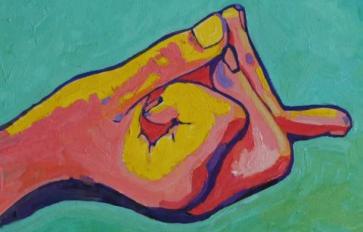
A dear friend gifted me the book How Yoga Works by Geshe Michael Roach. After tearing away the wrapping paper to expose a yellow cover displaying the chin mudra and the title How Yoga Works, my initial thought was, Okay, an instructional book about yoga…nice.
This initial reaction – judgment – was the first of countless lessons this [not-too] philosophical book has taught me. How Yoga Works is exactly NOT the type of instructional book about yoga that one might generally imagine, with diagrams and bullet points and how-tos. Just in its title, this book teaches that we, as individuals in a greater society, have overwhelmingly narrow ideas and preconceived notions of what and how things should be/can be/will be. How yoga works is not always what we expect it to be or how we expect it to work, nor is there only one way to learn how yoga works. It is possible to learn about yoga from an easily readable list of instructions, but it is certainly not the only way one can learn yoga in a holistic sense. One has to experience yoga, feel it, practice it, practice it again, and from that, gain other forms of knowledge that cannot be found solely in an instructional book about how yoga works. Roach has created a delightful novel in How Yoga Works, allowing the reader to experience and learn about yoga in a non-academic, real-world way that undeniably leads to a deeper knowledge of, well, how yoga works for each individual in extraordinarily unexpected ways.
Geshe Michael Roach is the only Westerner to receive the title of Geshe from the Sera Mey Tibetan Monastery in Tibet after over 20 years of study there. In addition to sharing his knowledge of Tibetan Buddhism through writing, he also teaches courses and lectures, and he has started several business ventures and organizations. His most well-known work is probably The Diamond Cutter (2000), about applying Buddhist teachings to his experiences as co-owner of a U.S. based jewelry manufacturing company. Roach is notorious as a non-traditional teacher of Tibetan Buddhism, and has also been the focus of much criticism regarding inconsistencies in his perspectives and teaching, activities, and behavior. Nonetheless, the narrative Roach has crafted in How Yoga Works is true to the genuine teachings of The Yoga Sutra – the source of all yoga, perhaps like the “yoga instruction manual.”
The premise of How Yoga Works is based around how one may use the ancient book of The Yoga Sutra (which was passed by word of mouth from teacher to student) to heal oneself and others in both body and heart. The Yoga Sutras – which is a collection of 196 aphorisms or short poems outlining Patanjali’s eight limbs of yoga – contains all one needs to know in order “to overcome any kind of illness or unhappiness; and to reach a place of splendid health, strength, and peace,” as is described on the back cover of How Yoga Works. Using brilliantly insightful (and at times stubborn) characters, Roach brings to light exactly how healing through yoga is indeed possible…and also far-reaching.
The story recounts a fictional rendition of how Patanjali’s Yoga Sutras arrived in India from Tibet. A young girl is stopped crossing the border into India, carrying the great book of the sutras, known to be of value. In order to prove that she has not stolen, the Captain of the jail allows the girl to leave her cell once each week to teach him the knowledge from the book in order to heal the pain in his back. And so the story unfolds from here; as the young girl and teacher of yoga sows the knowledge of the sutras in the Captain’s mind, healing diffuses throughout the Indian village in which she is perceived “captive.”
Through the character of the young girl, Roach translates the sutras in a way that both the Captain and the reader may share lessons in yoga, as Patanjali (the father of yoga) first communicated them. As with any narrative, the reader may take or leave any aspect of the book, interpreting as he or she pleases, like the Captain himself. Roach returns, again and again, to how yoga enables one to overcome the struggles of the mind and the nature of subjective thought. The young girl teaches the Captain that nothing really has any meaning except for the meaning we assign in our minds. Basically, perspective depends completely upon the vantage point. I first saw this book – only viewing the cover – as an instructional book on yoga. After opening and reading this book, I see that I’d associated a particular meaning with the combination of words in the title, How Yoga Works, and now I see that those words don’t necessarily always mean what I think.
How Yoga Works is packed with meaningful quotes, not to mention a breakdown of many of the Yoga Sutras. I highly recommend this book for the purpose of deepening your applicable understanding of the Yoga Sutras in the somewhat simplified and entertaining format of a narrative. If you’re open to understanding new perspectives and to taking the time for profound philosophical and personal inquiry, this book should definitely be on your “To Read” list. If you are not interested in deepening your understanding of yoga philosophy, however, How Yoga Works may not be ideal for plot junkies and stylistic specialists. If you’re to pick up this book, though, the following quote (among many others!) from the book is for you: take it or leave it, process it and question it.
And so what I mean, Captain, is that I am offering you new ideas. A new way of viewing the world: a new way of understanding how things really work, and how we can stop even the grand mistakes of unhappiness, the aging of the body, and death itself. But you must listen with an open mind; a mind opened by the realization that the way we were taught to view the world simply doesn’t work on the most important points of our life. (257)








